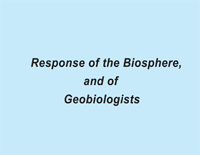|
Teaching Slides: Response of the biosphere
|
|
Here are teaching slides for "Response
of the biosphere". You can see a full-size version
by clicking on the thumbnail. You can then download that slide individually
by simply dragging it to your desktop.
|
|
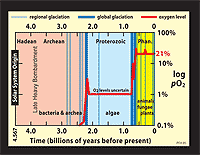 | 12.2:Postulated
rise in atmospheric oxygen over geologic time, and its relationship to
ice ages (blue bars) and biospheric evolution.
|
|
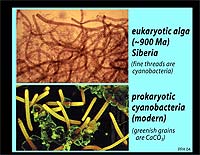 | 12.3:
Modern cyanobacterium (below); eukaryotic (vaucherian) alga from the
Riphean (~900 Ma) of Siberia (above). For size comparison, the fine threads
(above) are filamentous cyanobacteria like those below. Both prokaryotic
and eukaryotic phototrophs and their dependents survived the Cryogenian
snowball earths.
|
|
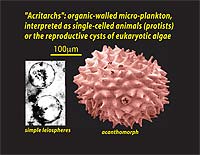 | 12.4:Acid-resistant,
organic-walled, micro-plankton ("acritarchs") are the only common
fossils in the Cryogenian and early Ediacaran Periods. During the Ediacaran,
acritarchs evolved from simple leiospheres (left) to larger, more diverse,
acanthomorphs (right). Acanthomorphic acritarchs disappear in the late
Ediacaran. The acanthomorph shown here is preserved three-dimensionally
in phosphorite of the Doushantuo Formation in South China.
|
|
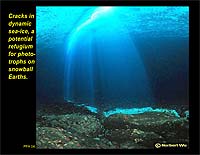 | 12.5:
Illumination through a crack in Antarctic sea ice. Crack systems will
perpetually exist wherever dynamic sea-glaciers physically encounter the
sea floor or areas of landfast ice. They were possibly an important refugium
for phototrophs on a snowball earth.
|
|
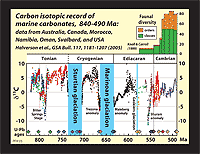 | 12.6:
Carbon isotopic record for marine carbonates from 820 to 490 Ma in Australia,
Canada, Svalbard, Namibia, Oman, Morocco and USA (modified after Halverson
et al., 2005). Also shown is a record of faunal diversity (Knoll & Carroll,
1999). Note that Ediacaran problematica make up much of the “faunal” diversity
at that time.
|
|
 | 12.7:
The oldest diverse (and abundant) representatives of the Ediacaran soft-bodied
macrobiota are preserved beneath volcanic ash layers 575-565 Ma on the
Avalon Peninsula of eastern Newfoundland, Atlantic Canada. They first appear
~5 Myr after the Gaskiers glaciation in the same succession. Many of the
forms were frond-like, with holdfasts attached to the sea-floor like modern “sea
pens”. The Ediacaran biota includes cnidarian sponges and one form,
Kimberella, found in younger (550 Ma) Ediacaran strata on the White Sea
Coast of Arctic Russia, is generally accepted to be a stem group mollusc.
But the once heretical view that few of the Ediacaran organisms were animals
appears to be gaining ground. They flourished up until the Ediacaran-Cambrian
boundary (442 Ma), when they suddenly disappear from the record in the
oldest-known mass extinction.
|
|
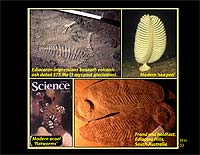 | 12.8:
Ediacaran soft-bodied macrofossils from Newfoundland and South Australia.
Sea pens and acoel flatworms are among the extant organisms with which
Ediacaran fossils have been compared. Their true biological affinities
remain unknown, perhaps unknowable.
|
|
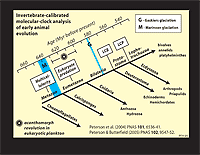 | 12.9:
Early animal divergence times, based on a “molecular clock” analysis
of extant organisms, calibrated with paleontologically-known invertebrate
divergence times (Peterson & Butterfield, 2005). According to this
analysis, the last common ancestor of all metazoa lived ~634 Ma, the
last common eumetazoan ~605 Ma, the last common bilaterian ~570 Ma and
the last common protostome ~550 Ma. The results broadly in accord with
the fossil record, assuming that early animals were microscopic before
~570 Ma. Eumetazoans were the first predators of eukaryotes (giant prey
compared with bacteria) and their evolution is suggested to be reflected
in a marked increase in size, diversity, ornamentation and turnover rate
among eukaryotic (acanthomorphic) plankton, observed to occur sometime
between ~630 and 600 Ma. Note that the appearance of eumetazoa (eumetazoan-calcisponge
divergence) is estimated to have occurred close to the time of the younger
Cryogenian (Marinoan) snowball earth.
|
|
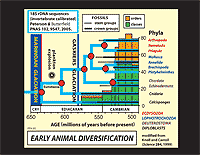 | 12.10:
Early animal diversity (Knoll & Carroll, 1999) and phylogenetic sequence
(blue lines) with divergence times calculated from an invertebrate-calibrated
molecular-sequence analysis of extant organisms (Peterson & Butterfield,
2005). The “plankton explosion” refers to a marked increase
in size, diversity, ornamentation and turnover rate among eukaryotic plankton
(acanthomorphic acritarchs), which is tentatively attributed to predation
by eumetazoa.
|
|

